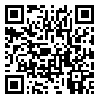Fri, Aug 1, 2025
| فارسی
Volume 18, Issue 2 (Summer 2016)
Advances in Cognitive Sciences 2016, 18(2): 12-25 |
Back to browse issues page
Download citation:
BibTeX | RIS | EndNote | Medlars | ProCite | Reference Manager | RefWorks
Send citation to:



BibTeX | RIS | EndNote | Medlars | ProCite | Reference Manager | RefWorks
Send citation to:
Seyed Khoshrou S M, Shariat S V, Sharifi M, Sadeghi Abdollahi B. Disgusting Pictures to Assess Visual Attention Processes in Obsessive-Compulsive Disorder: Test Development and Preliminary Validation. Advances in Cognitive Sciences 2016; 18 (2) :12-25
URL: http://icssjournal.ir/article-1-475-en.html
URL: http://icssjournal.ir/article-1-475-en.html
Seyedeh Mojgan Seyed Khoshrou1 
 , Seyed Vahid Shariat *2
, Seyed Vahid Shariat *2 
 , Massoud Sharifi3
, Massoud Sharifi3 
 , Bahar Sadeghi Abdollahi4
, Bahar Sadeghi Abdollahi4 


 , Seyed Vahid Shariat *2
, Seyed Vahid Shariat *2 
 , Massoud Sharifi3
, Massoud Sharifi3 
 , Bahar Sadeghi Abdollahi4
, Bahar Sadeghi Abdollahi4 

1- Department of Cognitive Psychology, Institute for Cognitive Science Studies, Tehran, Iran.
2- Mental Health Research Center, School of Behavioral Sciences and Mental Health, Institute for Cognitive Science Studies, Iran University of Medical Sciences, Tehran, Iran.
3- Faculty of Education and Psychology of Shahid Beheshti University, Tehran, Iran.
4- Center of Shariati Hospital, Tehran, Iran.
2- Mental Health Research Center, School of Behavioral Sciences and Mental Health, Institute for Cognitive Science Studies, Iran University of Medical Sciences, Tehran, Iran.
3- Faculty of Education and Psychology of Shahid Beheshti University, Tehran, Iran.
4- Center of Shariati Hospital, Tehran, Iran.
Abstract: (4440 Views)
Objective: Investigations have suggested that people with an obsessive-compulsive disorder have an impaired processing of threatening information and attentional bias toward such stimuli. Meanwhile, according to the important role of disgusting stimuli in the persistence of obsessive-compulsive disorder, more research is needed to evaluate the visual attention of these people with regards to the disgusting stimuli. The choice of proper disgusting pictures for the assessment of visual attentional processes in obsessive-compulsive disorder is yet to be addressed. This research aimed to develop and validate a test serving the above purpose using disgusting and matched neutral pictures.
Method: To this end, 113 paired disgusting pictures which were matched with neutral ones in terms of size, resolution, complexity and background, were selected through a thorough search in the web. Assessment of the external validity of the pictures was performed by five independent psychiatrists and clinical psychologists. As such, 73 neutral and 80 disgusting pictures which met the experts’ criteria were selected. To assess the internal validity, pictures were submitted to 20 subjects with obsessive-compulsive disorder (12 cases with washing rituals and 8 without). Subjects were then asked to evaluate the pictures based on the four dimensions including, valence, arousal, disgusting and threatening load from 1(lowest) to 9 (highest).
Results: the results of discriminant validity evaluation and reliability of measures, indicated that the pictures which were selected in this study as disgusting-neutral pictures are sufficiently valid and reliable.
Conclusion: pictures which were selected in this study as disgusting-neutral pictures could be suitable for the assessment of visual attention processes in patients with obsessive-compulsive disorder and washing rituals.
Method: To this end, 113 paired disgusting pictures which were matched with neutral ones in terms of size, resolution, complexity and background, were selected through a thorough search in the web. Assessment of the external validity of the pictures was performed by five independent psychiatrists and clinical psychologists. As such, 73 neutral and 80 disgusting pictures which met the experts’ criteria were selected. To assess the internal validity, pictures were submitted to 20 subjects with obsessive-compulsive disorder (12 cases with washing rituals and 8 without). Subjects were then asked to evaluate the pictures based on the four dimensions including, valence, arousal, disgusting and threatening load from 1(lowest) to 9 (highest).
Results: the results of discriminant validity evaluation and reliability of measures, indicated that the pictures which were selected in this study as disgusting-neutral pictures are sufficiently valid and reliable.
Conclusion: pictures which were selected in this study as disgusting-neutral pictures could be suitable for the assessment of visual attention processes in patients with obsessive-compulsive disorder and washing rituals.
Type of Study: Research |
Subject:
Special
Received: 2016/11/25 | Accepted: 2017/02/23 | Published: 2017/06/26
Received: 2016/11/25 | Accepted: 2017/02/23 | Published: 2017/06/26
Send email to the article author
| Rights and permissions | |
 |
This work is licensed under a Creative Commons Attribution-NonCommercial 4.0 International License. |

